Electricity
Electricity
The following text is used only for teaching, research, scholarship, educational use and informative purpose following the fair use principles.
We thank the authors of the texts and the source web site that give us the opportunity to share their knowledge
Physics
Electricity
Syllabus
Test electrical conduction in a variety of materials, and classify each material as a conductor or insulator
Set up a simple electric circuit, use appropriate instruments to measure current, potential difference (voltage) and resistance, and establish the relationship between them
Demonstrate simple series and parallel circuits containing a switch and two bulbs
Perform simple calculations based on the relationship between current, potential difference (voltage), and resistance
Describe the heating effect, the chemical effect, and the magnetic effect of an electric current, and identify everyday applications of these, including the action of a fuse
Distinguish between direct and alternating current; recall that the voltage of the mains supply is 230 volts a.c.
Recall that the unit of electrical energy used by electricity supply companies is the kilowatt-hour, and calculate the cost of using common electrical appliances, based on their power rating
Describe how to wire a plug correctly, and explain the safety role of a fuse or circuit breaker in domestic electrical circuits.
Student Notes
Conductors and Insulators
Remember our definitions of conductors and insulators from the chapter on Static Electricity:
A conductor is a substance that allows charge to flow through it easily (metals are conductors).
An insulator is a substance that does not allow charge to flow through it (plastics are insulators).
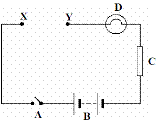
Experiment: Identify materials as conductors or insulators
- Set up the circuit as shown.
Label |
Circuit component |
A |
Switch |
B |
Power supply |
C |
Resistor |
D |
Bulb |
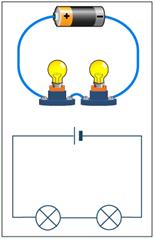 Place various different materials between points X and Y in the circuit and turn on the switch.
Place various different materials between points X and Y in the circuit and turn on the switch.- If the bulb lights then the material is a conductor and if it doesn’t then the material is an insulator.
Resistors
A resistor is used to reduce the flow of current in a circuit.
A series circuit
This is where the two bulbs are connected one after the other.
All the current coming from the battery goes through both bulbs.
Advantage: Uses less electricity than if the bulbs are connected in parallel.
Disadvantage: If one bulb blows the circuit is broken and so no current flows, e.g. lights in a Christmas tree.
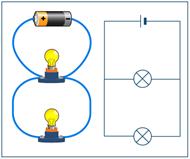 A parallel circuit
A parallel circuit
The current coming from the battery splits up and some goes through each bulb.
Advantage: If one bulb blows there will still be a complete circuit through the other bulb so it will remain lit.
Light bulbs in a house are generally connected in parallel for this reason.
Disadvantage: It uses more electricity than if connected in series.
Current, voltage and resistance
Current is a flow of charge (the charge is usually electrons)
- Current
- The unit of current is the amp (the symbol for the amp is A).
- The symbol for current is I.
- Current is measured with an ammeter or multimeter.
For current to flow we need two things:
1. There has to be a complete circuit.
2. There has to be a source of potential difference (power supplies and batteries both act as a source of potential difference).
- Potential difference (commonly called ‘voltage’)
Current will flow between two points if there is a potential difference between the two points.
This is a bit like saying that water will flow between two points if there is a height difference between the two points.
In an electric circuit current flows from the positive end of the battery to the negative end.
The positive end is represented with a long solid line, and the negative end is represented with a short solid line
Another way of thinking about potential difference is that it provides the ‘push’ to move the electrons around a circuit.
- The unit of potential difference is the volt (the symbol for the volt is V)
- The symbol for potential difference is V.
- Potential difference is measured with a voltmeter or multimeter.
Resistance opposes the movement of electrons around a circuit
- Resistance
- The unit of resistance is the ohm (the symbol for the ohm is Ω).
- The symbol for resistance is R.
- Resistance is measured with an ohmmeter or mulitmeter.
Summary
Quantity |
Symbol |
Unit |
Symbol |
Measured with |
Symbol |
Current |
I |
Amps |
A |
Ammeter |
|
Potential |
V |
Volts |
V |
Voltmeter |
|
Resistance |
R |
Ohms |
Ω |
Ohmmeter |
|
Relationship between current, potential difference and resistance
V = RI
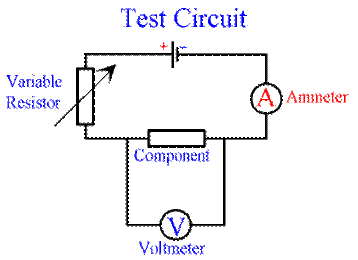 Experiment: To establish the relationship between potential difference and current
Experiment: To establish the relationship between potential difference and current
- Set up the circuit as shown and note the current (I) and potential difference (V)
- Adjust the variable resistor (rheostat) to get a new set of values.
- Repeat about 6 times and then plot a graph of potential difference against current.
- The fact that we get a straight line shows that the potential difference is proportional to the current (this means that if we double the potential difference, the current will double also).
- Note that the slope of the graph corresponds to the resistance of the component.
Maths problems
Calculate the resistance of a resistor when 20 V produces a current of 4 A.
Answer
R = V÷I = 20 ÷ 4 = 5 Ohms
Effects of an electric current
There are three effects of an electric current; a heating effect, a magnetic effect and a chemical effect
Effect |
Demonstration |
Everyday application |
Heating Effect |
An electric current will cause a light-bulb to heat up and emit light |
Electric kettle, electric fire etc. |
Magnetic Effect |
An electric current will deflect a magnetic compass |
Electromagnets |
Chemical Effect |
Electrolysis occurs when an electric current splits water into hydrogen and oxygen |
Electroplating |
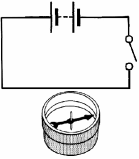
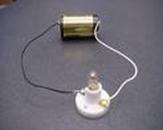
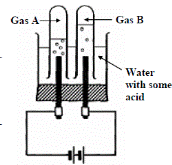
Alternating Current (a.c.) and Direct Current (d.c.)
Direct current is current which flows in one direction only; alternating current is current which constantly changes direction.
Mains Electricity
Electricity which comes through the sockets in your house is referred to as ‘mains’ electricity’.
It changes direction 50 times per second and so is called alternating current (a.c.).
‘Mains’ voltage is 230 volts
Look at the back of your electrical appliance and it will state this voltage and also the power.
Fuses
A fuse is a deliberate weak link in a circuit which will break (melt) if the current exceeds a preset value
The 3-pin plug
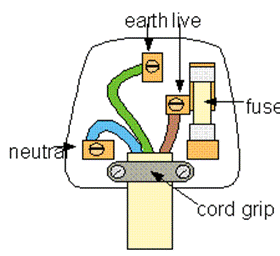
- The neutral wire is blue.
- The earth wire is yellow or green.
- The live wire is brown or red.
- The fuse is on the live wire.
Cost of electricity - the kilowatt-hour
The unit of electrical energy used by electricity supply companies is the kilowatt-hour
The number of kilowatt-hours equals the number of kilowatts multiplied by the number of hours
kWh = kW × hours
The ESB charges for electricity at a rate of 11 cent per kW h.
A hair-drier of power rating 1.5 kW is used for 20 minutes each day.
(i) How many units of electricity are used?
(ii) What is the cost, in cent, of using the hair- drier for six days?
Answer
- Six days corresponds to 120 minutes or 2 hours.
The number of kWh = kW × hours = 1.5 × 2 = 3 kWh
- Cost = 3 kWh × 11 cent per kWh = 33 cent
Fill in the following table using the formula V = IR:
Potential Difference |
Current (I) |
Resistance |
10 |
5 |
|
|
2 |
200 |
120 |
|
30 |
100 |
2 |
|
|
0.5 |
20 |
120 |
|
10 |
Fill in the following table:
Watts (W) |
kilowatts |
Hours |
kWhr |
Cost |
50 |
0.05 |
60 |
3 |
24 |
20 |
|
5 |
|
|
1000 |
|
1 day |
|
|
500 |
|
10 minutes |
|
|
60 |
|
1 week |
|
|
Activity:
Check appliances at home (e.g. hairdryers, lamps, heaters etc) to find the power rating and use this to fill in the table below.
Appliance |
Power-rating (kW) |
Average hrs used in a week |
kWhr per week |
Cost over 1 week @ 9p per unit (kWhr) |
|
|
|
|
|
|
|
|
|
|
|
|
|
|
|
|
|
|
|
|
|
|
|
|
|
The power rating of various appliances
You don’t have to remember the numbers – just remember which machines use a lot of power and which use relatively little.
In general, if an appliance has a motor in it (something which moves) then it will have a high power rating.
Appliance |
Power (in watts) |
Washing machine |
2500 |
Microwave |
1000 |
|
|
|
|
|
|
|
|
Light-bulb |
40 |
|
|
Exam questions
- [2008 OL]
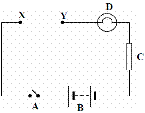 The diagram shows a simple electrical circuit.
The diagram shows a simple electrical circuit.
Label |
Circuit component |
|
Bulb |
|
Power supply |
|
Resistor |
|
Switch |
Complete the table below correctly matching each of the names of the components in the circuit with one of the labels A, B, C or D.
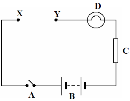 [2008 OL]
[2008 OL]
You are given a piece of copper metal and a piece of timber.
Which piece, metal or wood, should you connect between X and Y in order that the bulb would light when the switch is closed? Give a reason for your choice.
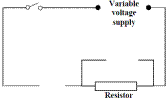
 [2007 OL]
[2007 OL]
A student set up the circuit shown to investigate the relationship between the potential difference (voltage), the current and the resistance of a wire conductor.
Gaps are left in the diagram in the places where the ammeter and voltmeter should be placed. The symbols for these devices are given on the right.
Complete the circuit inserting the symbols for the ammeter and the voltmeter in their correct positions.
 [2007]
[2007]
The symbols for two electrical meters are given in the diagram.
The symbol![]() is for a meter that measures potential difference, often called ‘voltage’.
is for a meter that measures potential difference, often called ‘voltage’.
What electrical quantity can be measured using the meter with the symbol ![]() ?
?
 [2006]
[2006]
Components, e.g. bulbs, in electrical circuits can be connected in series or in parallel.
It is noticed that, when one headlight fails (blows) in a car, the second remains lighting.
- State the way the headlights are connected and give a reason why this mode of connection is used.

- All of the bulbs go out in an old set of Christmas tree lights, when one of bulbs fails (blows).
In what way are the bulbs connected in this set of lights?
- Explain why, when one bulb blows, they all go out.
- [2006]
Calculate the resistance of the filament of a car headlamp when 12 V produces a current of 5 A in it.
In what unit is resistance measured?
- [2007 OL]
The student used the variable voltage supply to apply different voltages across the resistor. She measured the voltage across the resistor and the current passing through it several times. She collected the following data.
Voltage (V) |
0 |
2 |
4 |
6 |
8 |
Current (A) |
0 |
0.5 |
1.0 |
1.5 |
2.0 |
- Draw a graph of the voltage (y-axis) against the current (x-axis).
- What conclusion can you draw from the graph about the relationship between the potential difference (voltage) and the current passing through the wire conductor?
- [2010 OL]
A student carried out an investigation of the relationship between current flowing through a wire resistor and the voltage across it.
The data collected is presented in the table below.
Current (A) |
0.2 |
0.4 |
0.6 |
0.8 |
1.0 |
Voltage (V) |
1 |
2 |
3 |
4 |
5 |
- Use this data to draw a graph of voltage (y-axis) against current (x-axis) using the grid provided below.
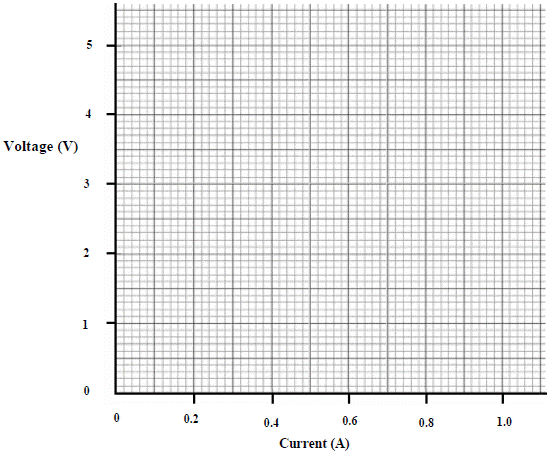
- Use the graph to estimate the current at 3.5 V.
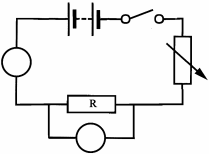 Name the instrument used by students to measure voltage.
Name the instrument used by students to measure voltage. - Name the instrument used by students to vary the current.
- What is the relationship between voltage and current in this investigation?
- [2007]
Meters ![]() and
and ![]() are used in the circuit shown.
are used in the circuit shown.
Enter ‘A’ into the appropriate circle of one of the meter symbols in the circuit diagram so as to clearly identify its correct position.
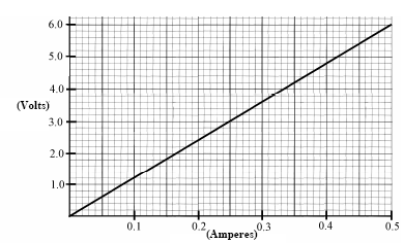 [2007]
[2007]
A pupil used the circuit above to get a set of readings from both meters for different values and then plotted this data in the graph shown.
Use this graph to calculate the resistance of resistor R shown in the diagram. Give the unit of resistance with your answer.
- [2007]
Give one application of the magnetic effect and one application of the chemical effect of electric current.
- [2008]
Distinguish between alternating and direct current.
- [2008]
What is the average voltage of domestic alternating current in Ireland?
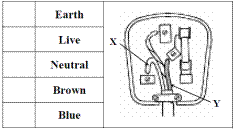
- [2006]
Explain, clearly, the safety role of fuses in household electrical circuits.
- [2007 OL]
The diagram shows a three-pin plug with the back removed.
- In the table below write the letter X beside the name of the wire labelled X in the diagram.
- Write the letter C beside the colour of the insulating on the wire labelled Y.
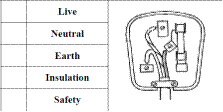 [2008 OL]
[2008 OL]
The diagram shows a three-pin plug with the back removed.
Answer the questions below using the table.
- In the table write the letter X opposite the name of the green and yellow wire.
- Write the letter Y opposite the name of the wire to which the fuse is connected.
- Write the letter Z opposite the function of the fuse in a plug.

- [2006 OL]
The diagram shows a three-pin plug with the back removed.
- What is the correct names for the cables labelled X and Y.
- Give one reason why the back covering (casing) of a plug is made from plastic.
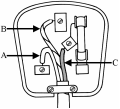 [2008]
[2008]
Wiring a plug correctly is most important.
Give the colour/s of any two of the plastic insulations on the wires labelled A, B and C.
|
Volt |
- [2008 0L]
- Write the letter C beside the unit of electric current.
- Write the letter E beside the unit of electricity used by the ESB for costing.
- [2006 OL]
Appliances vary in the amount of electricity they use depending on their power rating.
A tumble drier has a high power rating of 2.5 kW.
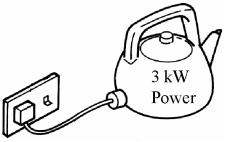 Name another appliance found in the home that has a high power rating.
Name another appliance found in the home that has a high power rating.- Name an appliance found in the home that has a low power rating.
- [2010]
- Name the unit of electrical energy that companies supplying electricity use to bill their consumers.
- Calculate the cost of using of using the electric kettle, shown in the diagram, for ten hours if a unit of electricity costs 15 cent.
- [2007 OL]
An electric cooker has four hot plates. The total power rating of the four hot plates is 7 kW.
All four are used for a total of 2 hours each day.
- How many units of electricity (kWh) are used in 1 week?
- If electricity costs 11 cent per unit how much does this cost?
- [2006 OL]
The ESB charges for electricity at a rate of 12 cent per kW h.
A tumble drier of power rating 2.5 kW is used for 2 hours each week for 4 weeks.
- How many units of electricity are used?
- What is the cost, in cent, of using the tumble drier?
Exam solutions
- A: Switch
B: Power supply
C: Resistor
D: Bulb / lamp
- Metal, because metal is a conductor and wood is an insulator
- Ammeter in series
Voltmeter in parallel (above the resistor).
- Current
- The headlights are connected in parallel because if one bulb blows the other remains on.
- They are connected in series.
- The circuit is broken.
- R = V/I = 12/5 = 2.4 Ohm/ Ω
(i) The graph should result in a straight line through the origin.
(ii)Potential difference is proportional to current.
- Correct line on its own / 5 points correctly plotted and join plotted points
- 0.7 ± 0.02
- Voltmeter / multimeter
- Rheostat / variable resistor / potentiometer / power supply
- Proportional / both increase at same rate [Current increases with voltage (i.e. no indication of proportionality – 3 marks only]
- ‘A’ goes into the circle on the left-hand side.
- The resistance corresponds to the slope of the graph.
Pick two points from the graph and use the formula slope = y2 – y1 / x2 – x1
Slope = 12 Ω or 12 Ohms
(accept 11.5 to 12.5)
- Magnetic effect: electromagnets/ door bells/ central locking in cars/ speakers.
Chemical effect: electroplating/ galvanising/ refining of copper.
- Alternating current changes direction, direct current moves in the same (fixed) direction
- 220-240 volts
- The fuse melts if the current is too high and this breaks the circuit.
- X: Neutral
- C: (Y) Brown
- X: Earth
- Y: Live
- Z: Safety
- X: Earth Y: Live
- To prevent shock (electrocution) / safety / insulates
- A is blue/ B is green and yellow / C is brown
- C: Ampere
- E: Kilowatt hour
- Cooker / kettle / toaster / washing machine / dish washer etc
- Reading lamp / radio / television
- lThe kiloWatthour (kWh)
- 3 × 10 = 30 kWh. 30 kWh × 15 cent = 450 cent / €4.5
- 7 × 2 × 7 = 98
- 98 × 11 = €10.78
- 2.5 × 2 × 4 = 20 kWh
- 20 × 12 = 240 cent
Electricity Crossword
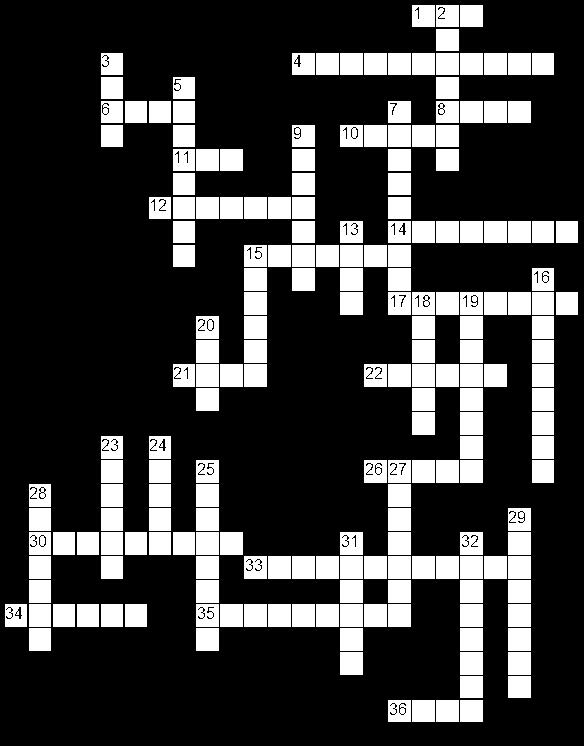
Across
1. The unit of resistance. (3)
4. This type of current constantly changes direction. (11)
6. The fuse is on this wire. (4)
8. Thin metal used to connect electrical components (4)
10. Colour of live wire in a plug. (5)
11. The unit of current. (3)
12. This must be complete in order for current to flow. (7)
14. Electrolysis is an example of this effect of an electric current. (8)
15. Movement of electric charge around a complete circuit. (7)
17. Electrical component used to reduce the flow of current in a circuit. (8)
21. Colour of neutral wire in a plug. (4)
22. An electric circuit with components placed one after the other. (6)
26. This type of voltage is 230 volts. (5)
30. Resistance opposes the movement of these around an electrical circuit. (9)
33. Unit of electrical energy used by electricity supply companies. (12)
34. Colour of earth wire in a circuit. (6)
35. A substance that does not allow charge to flow through it. (9)
36. A thin metal wire that is designed to melt when the electric current is too large. (4)
Down
2. The kettle and electric kettle are examples of this effect of an electric current. (7)
3. The unit of potential difference (or 'voltage'). (4)
5. The opposite of positive, usually has a black terminal. (8)
7. A substance that allows charge to flow through it easily. (9)
9. Two or more electric cells form one of these. (7)
13. Two or more of these in series form a battery. (4)
15. Electric current is the flow of ... (6)
16. Electrical device that measures potential difference (voltage). (9)
18. Light, sound, heat, kinetic, electrical and chemical are all forms of ... (6)
19. Arrangement of bulbs in a christmas tree. (8)
20. An electrical component that transforms electrical energy into heat and light. (4)
23. This type of current flows in one direction only. (6)
24. The rate of transforming energy. (5)
25. The compass is an example of this effect of an electric current. (8)
27. Electrical device that measures electric current. (7)
28. Electrical component that transforms electrical energy into sound energy. (7)
29. An electric circuit with more than one complete loop. (8)
31. This is used to make or break a complete circuit. (6)
32. The opposite of negative, usually has a red terminal. (8)
Other Test Questions
- Why is electricity a convenient form of energy?
- What is an electric current?
- What is the unit of current?
- What is the unit of voltage (also called the potential difference)?
- What is the unit of resistance?
- Name an instrument used to measure electric current.
- Name an instrument used to measure voltage.
- Name an instrument used to measure resistance.
- What two conditions are required in order for current to flow in a circuit?
- List three effects of an electric current.
- Draw a diagram of the apparatus used to demonstrate each of the three affects of an electric current.
- Name one everyday useful application of the heating effect of an electric current.
- Name one everyday useful application of the magnetic effect of an electric current.
- What are the three terminals in a plug called?
- What colour wire is attached to each terminal?
- What is the function of the earth wire?
- What is the function of a fuse in a circuit?
- Which wire is the fuse on, and why?
- What voltage is mains electricity?
- A hair-dryer uses 5 amps of electricity. Will it operate if its plug has a 3 A fuse? Give a reason for your answer.
- The expected current flowing through a certain circuit is 2.4 Amps. Which of the following fuses is most appropriate; 1A, 2 A, 3A, 5A or 13A?
- Draw the symbol for each of the following underneath the word
Resistor Switch Voltmeter Light Bulb Battery Rheostat
- What is meant by the term ‘Potential Difference’ (or ‘Voltage’) as it applies to a circuit?
- You are given a battery and two light-bulbs.
- Draw a circuit diagram showing the batteries arranged (i) in parallel, (ii) in series.
- Which circuit will be brighter?
- In which circuit will the battery last longer?
- Which circuit is more likely to represent the arrangement of Christmas lights? Why?
- A battery provides a potential difference of 9 volts across a metallic conductor of resistance 0.5 ohms. Calculate the current flowing through the circuit.
- Fill in the table
Voltage |
Current |
Resistance |
Power |
Time |
kW Hours |
Cost per unit |
Total cost |
200 |
5 |
40 |
1000 |
2 |
2 |
6 |
|
500 |
2 |
|
|
3 |
|
7 |
|
|
3 |
25 |
|
|
6 |
|
|
220 |
2 |
|
|
|
|
|
|
1000 |
|
|
2500 |
|
10 |
|
|
V= IR, P = VI
- Draw a fully labelled diagram of the apparatus used in the experiment to establish the relationship between potential difference and current.
- Sketch the graph which you would expect to obtain from this experiment.
What does the slope of the graph represent?
- The measurements made by a student in an experiment to establish the relationship between potential difference and current are shown in the table.
Voltage (V) |
1.0 |
2.0 |
3.0 |
4.0 |
5.0 |
6.0 |
Current (A) |
0.1 |
0.2 |
0.3 |
0.4 |
0.5 |
0.6 |
- Use the table to draw a graph – on graph paper - of voltage against current.
Put voltage on the Y-axis.
- What is the relationship between potential difference and current?
Give a reason for your answer.
- Calculate the resistance of the resistor used in this experiment.
- Draw a diagram to show how two light bulbs can be connected in series with a battery.
- Draw a diagram to show how two light bulbs can be connected in parallel with a battery.
- Why are most light bulbs arranged in parallel instead of in series?
The kilowatt-hour
- What is the unit of electrical energy used by the E.S.B. on electricity bills?
- What is the rule used to calculate the number of kilowatt-hours used by an appliance?
- Give a typical power rating (in watts) of any electrical appliance that you have at home. Name the appliance.
- Calculate the cost of running a 2.4kW electric fire for 5 hours if each unit of electricity costs 8 pence.
- A 600 Watt cooker is on for 30 minutes. If each unit of electricity costs 11 cent, calculate the cost of running the cooker.
Source : http://www.thephysicsteacher.ie/JC%20Science/JC%20Physics/Student%20Notes/14.%20Electricity.doc
Web site link: http://www.thephysicsteacher.ie
Author : not indicated on the source document of the above text
If you are the author of the text above and you not agree to share your knowledge for teaching, research, scholarship (for fair use as indicated in the United States copyrigh low) please send us an e-mail and we will remove your text quickly.
Electricity
Electricity
Electricity
This is the right place where find the answers to your questions like :
Who ? What ? When ? Where ? Why ? Which ? How ? What does Electricity mean ? Which is the meaning of Electricity?
Electricity physics notes
Alanpedia.com from 1998 year by year new sites and innovations
Main page - Disclaimer - Contact us